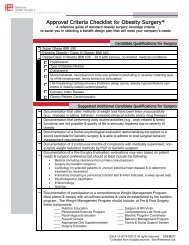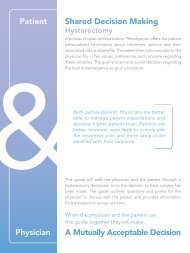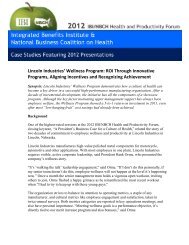Obesity/Weight Management Employer Survey and Interview Project
Obesity/Weight Management Employer Survey and Interview Project
Obesity/Weight Management Employer Survey and Interview Project
- No tags were found...
You also want an ePaper? Increase the reach of your titles
YUMPU automatically turns print PDFs into web optimized ePapers that Google loves.
Barriers for <strong>Employer</strong>s to Take Action. Severalimportant barriers were noted by respondents, yet.from the background research <strong>and</strong> current information,these barriers would appear surmountable (Figure 11).The main barriers included:E Lack of employee engagement,E Lack of time for employees to participate, <strong>and</strong>E Lack of staff to manage the programs.Additional commonly reported barriers included alack of financial resources, lack of employee data onoverweight/obesity, difficulty discussing the topic withemployees, lack of knowledge about where to start orwhat to do, <strong>and</strong> legal concerns (such as the Americanswith Disabilities Act or the Health Portability <strong>and</strong>Accountability Act). The least common barriers werelack of leadership support, lack of space, <strong>and</strong> lack ofclear evidence or data.Even though there is compelling evidence that obesityhas an impact on the workplace, the most significantbarrier is employee engagement.E Lack of employee engagement is the top rated barrier;it is always or very often a problem for employers(57.3%). Symptomatic of the difficulty in engagingemployees are other highly rated barriers such as: Lack of employee time to participate (54.3%of employers rated this as always/very often abarrier.), Difficulty in discussing the issue of overweight/obesity with employees (44.1% of employersresponded that this issue was always or veryoften a barrier.)E In terms of organizational support that could assistwith better employee engagement, the three barriershighly rated by participating employers were: Lack of staff time (54.2% rated as always/veryoften a barrier.), Lack of financial resources (42.9% rated asalways/very often a barrier.), Lack of knowledge in where to start/what to doin terms of addressing overweight/obesity in theworkplace (41.4% rated as a persistent barrier.).Lack of leadership support was only mentioned as asignificant barrier by 32.3% of responding employers.While still high, this shows that many businessleaders underst<strong>and</strong> <strong>and</strong> are supportive of activities toaddress workplace obesity. <strong>Interview</strong>ees exp<strong>and</strong>edon this topic, saying that their employer does notwant to be intrusive or overbearing to overweight/Figure 11: Barriers to Developing orEnhancing a Worksite <strong>Obesity</strong> ProgramAlwaysVery Often50%45%40%35%30%25%20%15%10%5%0%Lack of Lack ofEmployee Time forEngagement Employeesto ParticipateLack ofStaffDi culty inDiscussing<strong>Obesity</strong> withEmployeesLack ofFinancialResourceLack ofKnowledgein where tostart/whatto do16National Business Coalition on Health









